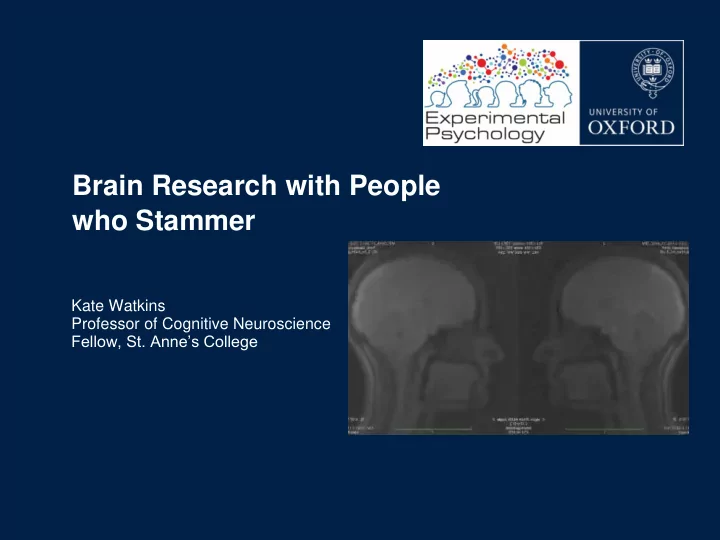

Brain Research with People who Stammer Kate Watkins Professor of Cognitive Neuroscience Fellow, St. Anne’s College
What I do: Brain Scanning Brain Stimulation Structure Function Magnetic Electric Methods applied in studies of children and adults who Stutter/Stammer, or with Developmental Language Disorder
Brain Function: functional MRI fMRI for Dummies
fMRI – scanning brain activity ROI fMRI ~2s Signal Time (% change) Course Condition Time Time ~ 5 min fMRI for Dummies
fMRI scans of people who stammer: Fluent Speakers People who stammer Red = Areas of the brain active when speaking
White matter structure: Diffusion MRI λ 1 λ 2 λ 3 FA ≈ λ 1 λ 2 + λ 3
Diffusion MRI ▪ Diffusion of water easiest along the long axis of fibres compared with across it ▪ From measuring diffusion of water in the brain we can infer the predominant direction of fibres
Weak white matter connections in people who stammer (multiple studies)
Weak white matter connections in people who stammer (multiple studies)
Transcranial Direct Current Brain Stimulation (tDCS) • Noninvasive • Weak electric current passed between two electrodes placed on the scalp • Mild tingling might be felt • (able to control for placebo effects, therefore) • Cheap, portable, safe • Effective in combination with a task (therapy/treatment) • Has no effect on its own
Randomised Controlled Trial using tDCS 30 adult men who stutter N=15 N=15 5 days “Sham” 5 days 1-mA tDCS tDCS 20 mins / day 20 mins / day with temporary with temporary Jen Chesters fluency induction fluency induction 1 week & 6 weeks follow up Registered with ClinicalTrials.gov number NCT02288598
Temporary Fluency Induction: 5 days 20 mins 1-mA tDCS / sham
DID IT WORK???? Five consecutive days of tDCS with temporary fluency induction can produce longer-lasting improvements to fluency with a reduction of about on third in stuttering symptoms Chesters, Mottonen & Watkins (2018) Brain
Effects of tDCS on brain activity: changes from pre- to 1-week post-intervention * * * Significant increases in activity from pre- to post-intervention in the tDCS relative to sham group in the dorsal striatum
What next? https://insteptrial.wordpress.com instep@psy.ox.ac.uk @InstepTrial
Thank you! Jen Chesters, Riikka Mottonen, Mairead Healy, Charlie Wiltshire Experimental Psychology, Mark Chiew, Steve Smith, WIN, University of Oxford Peter Howell, UCL
Reading change in % disfluent syllables 4 Fluency before and 2 after the intervention 0 TDCS -2 on each training day Sham -4 -6 -8 pre post pre post pre post pre post pre post Day 1 Day 2 Day 3 Day 4 Day 5 Conversation change in % disfluent syllables 4 Both groups responded well to the temporary 2 fluency inducers 0 TDCS (< 1.5 % ds during the Sham -2 intervention) -4 -6 -8 pre post pre post pre post pre post pre post Day 1 Day 2 Day 3 Day 4 Day 5
Reading vs. Conversation The effect of tDCS was evident in both reading and conversation samples 1 week after the intervention but only persisted for reading at 6 weeks
Secondary Outcomes Clinical measure of stuttering severity Psychosocial Impact * * tDCS significantly reduced stuttering severity score The effect was significantly smaller at 6 weeks Both groups showed a small reduction in the psychosocial impact of stuttering after the intervention
Summary of RCT findings ▪ Five consecutive days of tDCS with temporary fluency induction can produce longer-lasting improvements to fluency ▪ One week after the intervention, fluency was improved (reduction in % disfluent syllables) for both reading -3.26 % and conversation -4.25 % ▪ Six weeks later, fluency remained improved for reading -4.68%; fluency during conversation had returned to baseline levels ▪ A clinical measure of stuttering severity (SSI-4) also showed significant improvement at both time points: 1 week: - 7.13; 6 weeks -3.40 Chesters et al., Brain 2018
Recommend
More recommend